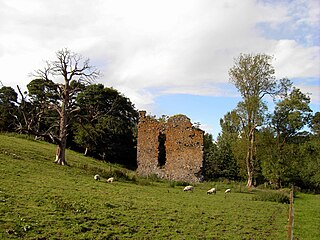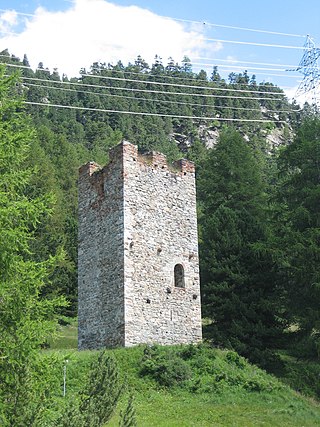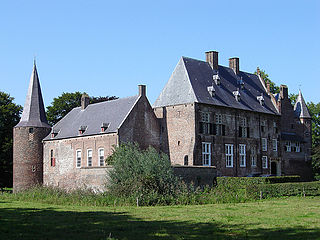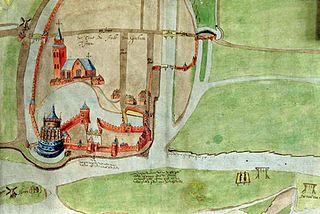
Nieuw-Lekkerland is a town in the western Netherlands, in the province of South Holland. It is situated on the southern shores of the Lek River, in the north-west of the Alblasserwaard.

Stuivekenskerke is a district of the town of Diksmuide, in the Belgian province of West Flanders. Located on the Yser river, until 1970 it was an independent municipality and then merged and became a sub-municipality of Diksmuide. Stuivekenskerke, built in a polder, has an area of 7.34 km2 and had 160 inhabitants in 2007.

Haaften is a village in the Dutch province of Gelderland, on the northern shore of the river Waal, about opposite Zaltbommel. It is a part of the municipality of West Betuwe, and lies about 25 km south of Utrecht.

Echteld is a village in the Dutch province of Gelderland. It is a part of the municipality of Neder-Betuwe, and lies about 6 km east of Tiel.

Belvelly Castle is a 14th or 15th-century tower house in County Cork, Ireland. It is situated next to the small village of Belvelly, opposite and overlooking the only road bridge connecting Fota Island to Great Island.

Vijfheerenlanden, literally "lands of five Lords", is a municipality in the province of Utrecht in the Netherlands. The municipality was created on 1 January 2019 through the merger of the former municipalities of Vianen (Utrecht), Leerdam and Zederik. Vijfheerenlanden has 59,150 inhabitants on 1 January 2022.
Hanstein Castle is a ruined castle in Central Germany near Bornhagen in the Eichsfeld, situated above the river Werra in Thuringia. The name of the nobles von Hansteins, most notable Fritz Huschke von Hanstein, derived from the castle.

Nether Horsburgh Castle is a ruined tower house near Cardrona, in the Scottish Borders, in the former county of Peebleshire. It is situated at the back of a farmstead, 3.5 miles (5.6 km) southwest of the market town of Peebles, at grid reference grid reference NT304396, on the A72 road. Access may be gained by permission from the adjoining farmstead, Nether Horsburgh Farm.

Crèvecœur Castle is a ruined castle in Belgium. The ruins of the Château de Crèvecœur are located in Bouvignes-sur-Meuse, part of the Belgian city of Dinant, province of Namur, Wallonia. The castle is owned by the Walloon Region. The ruin field can be visited freely all year.

Egmond Castle, also called the Ruins of Egmond, is a ruined medieval castle in the Dutch province of North Holland. It is located in Egmond aan den Hoef in the municipality of Bergen and lies about 7 kilometres (4.3 mi) west of Alkmaar. The castle dates from the 11th century and is the ancestral seat of the Egmond family, whose members became sovereign Dukes of Guelders, Counts of Egmond and Princes of Gavere, Counts of Buren and Leerdam. It is a national monument of the Netherlands.

Cannenburg Castle or Cannenburch Castle is a castle with a moat in the Netherlands. It is situated in Vaassen, a town in the province of Gelderland.

Spaniola Castle is a ruined castle in the municipality of Pontresina of the Canton of Graubünden in Switzerland.

The Skhvilo fortress, also known as Skhvilo castle, is a medieval fortress located in the region of Shida Kartli, in Kaspi District, Georgia. It was built in the 14th century, and served as the first residence of the duke (tavadi) family Amilakhori.

Hernen Castle is a Dutch castle from the 14th century.

Poelwijk Castle is an estate and former castle located to the south of the town of Gendt, part of the municipality of Lingewaard in the Dutch province of Gelderland. The moat and a residential tower of the castle have been preserved. The residential tower is a national monument.

Waardenburg Castle, sometimes also called Weerdenburg, is a medieval castle located in Waardenburg in the municipality of West Betuwe, in the Dutch province of Gelderland.

Saeftinghe Castle was a castle on the northeast tip of the drowned land of Saeftinghe. It was destroyed by flooding in the 16th century, and now its exact location is unknown.

Castle Buren or Buren Castle was a princely residence in Buren in the Dutch province of Gelderland. The castle was one of the largest castles in the Netherlands. It was the seat of the Buren branch of the Egmond family, as well as of the House of Orange. It has been demolished in the 19th century. Today, not much remains except a monument in the former bailey of the castle as well as model in the local museum.

The Blue Tower was a castle with an imposing stone keep in Gorinchem, the Netherlands. It was a princely residence of Charles the Bold, Duke of Burgundy. The complex, which stood there between 1461 and 1578, gained an almost mythical status thanks in part to descriptions by the Gorinchem chronicler Abraham Kemp and the discovery of its foundations in 1983.


















